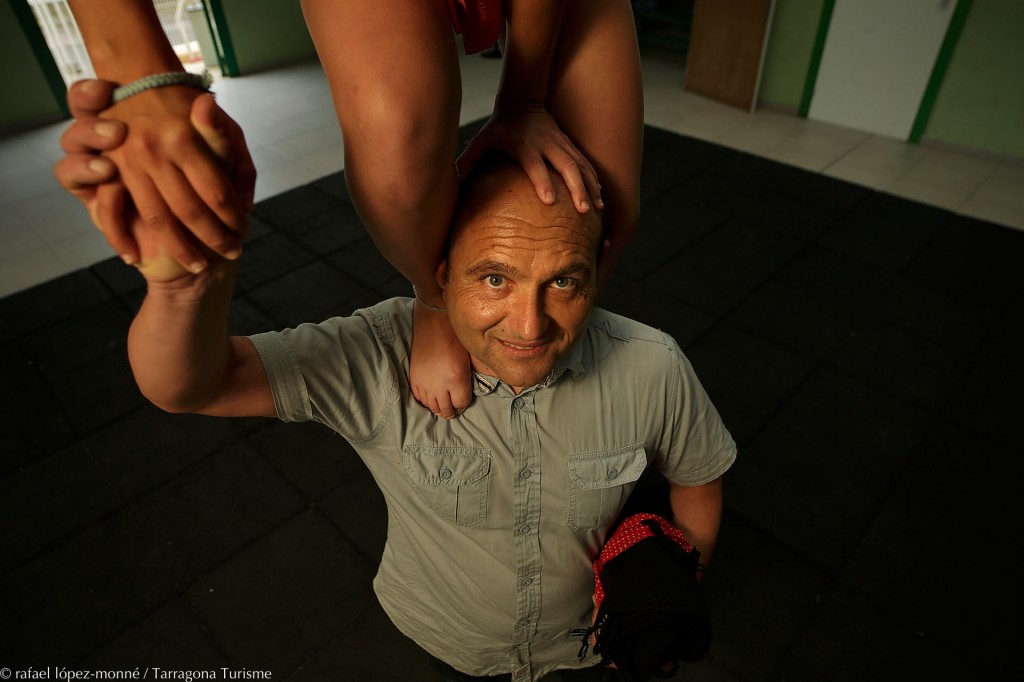When Losada sent the ball over the crossbar on the very last penalty shot during the UEFA Final game between Espanyol and Bayern Leverkusen (1988), Ricard Marrugat, one of the few Espanyol supporters (perico) in Gandesa, cried like a small child. He came back brimming with hope twenty years later in the time of De La Peña, Tamudo and Luis García, and decided to go on a pilgrimage with his team to the final in Glasgow. It was an austere trip, with no place to sleep. Espanyol was defeated again in the penalty shootout. Marrugat though, president of Castellers de Sant Pere i Sant Pau does not give up easily. He has learnt how to see the bright side of failures while stopping his group from becoming discouraged. “There should be motivation, although in Castells, one must find the way to recover”, he says; in every possible sense.
Born in 1990, the Colla Castellera de Sant Pere i Sant Pau has not the status of the two other great ‘colles’ of the city, the Xiquets and the Colla Jove, and yet, thanks to a renovation process of his core in recent years, its constructions are becoming more and more important and it is determined to enter the top20 in the short term. Marrugat, who joined the ‘colla’ a few years ago thanks to his son, knows the importance of keeping the illusion of projects alive. Despite the fact that ‘castells’ tend to go for the stars, he thinks it is essential to keep at least one foot firmly on the ground, in the same way the garnatxa vines he grows do in Gandesa. “When everything’s ok and the colla improves, no problem. However, one must get to know people and find the best way to speak when things go wrong. Only then can a setback work as the ideal push to keep on moving forward”, he explains.
Together with the Xiquets del Serralloo, Xiquets and La Jove, as well as other invited groups, Sant Pere i Sant Pau’s performances play a central role this summer in different spots around the city as part of the programme Tarragona, Ciutat de Castells. This initiative was designed to give visibility to the local Castells’ activity, to position the city as a reference in this field, and to work as October’s Concurs warm-up, the actual World Cup in the Castells calendar. Besides exhibitions, shows and workshops, the programme provides tourists with a unique opportunity to attend rehearsals. “We want to divulge our activity. We all win here”, Marrugat states. Sant Pere i Sant Pau is named after a 16,000-people neighbourhood; unfortunately, and due to its tiny dimensions, it can barely get new associates, the actual seed for new castells.
Human towers are a concept that is an essential part of Tarragona, which has experienced ups and downs throughout history, and which was reborn in recent decades coinciding with the restoration of democracy. Just like other associations born these years with the purpose of putting new energy to the city’s popular heritage, the castell groups (colles castelleres) are working as a sort of meeting point for different generations and sensibilities, people from various origins that are playing a certain role for the benefit of teamwork. Thus, they become a powerful instrument to provide assistance to the social structuring.
The square is the entire reason of being for castells. The colla Sant Pere i Sant Pau goes on 20 to 25 sortides (trips that involve a performance, a competition), which can gather up to 120 members of the group. It is during the rehearsals though –twice a week-, especially those involving difficult human towers, according to Marrugat, that one gets both the responsibility and the emotional implication of the members of the ‘colla’. “When we try important things, the room becomes silent; we’re not performing for the people, it is about oneself. Celebrations are also more effusive that in the square”, he says.
Marrugat, director of Institut Terra Alta, believes castells to include values related to education, such as thoroughness, motivation and evaluation. This is why, each year, 15-year-old teenagers of the mentioned institute come to Tarragona in order to create their final academic paper. “Castells improve people”, he states.
Text: Oriol Margalef (@OhMargalef on Twitter)
Pictures: Rafael López-Monné (@lopezmonne on Twitter)
Translation: Artur Santos (@artur_1983 on Twitter)




